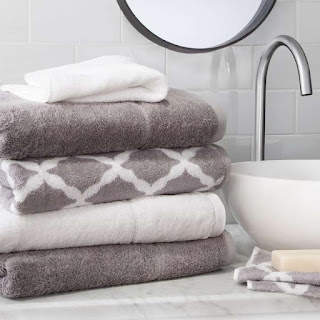The last thing you want to do when you step out of a nice
warm shower is dry yourself off with a nasty-smelling towel. The stench can be
overwhelming, and it really puts a damper on that “fresh from the shower”
feeling. Luckily, this problem is easy to solve! With a few strategic cleaning
cycles, the musty stench can be a thing of the past.
Here’s how:
The Golden Towel Rule: Do not let your towels stay wet! For
each of these methods, it’s important that the towels are dried immediately.
Set a timer to ensure that your clothes are switched from the washing machine
to the dryer promptly. If you line dry, hang the wet towels in a sunny spot
until they’re completely dry.
Method #1: Vinegar Riding Solo
Musty, smelly towels don’t play well with others, so give
them their own load. Add one cup of white vinegar to the load – no detergent or
fabric softener – and run the washer on the hottest possible setting. The
vinegar will kill any lingering bacteria. Then, leave the clothes in the
washing machine and run a “normal” load with a standard amount of detergent. Tip: Don’t add other items to your cycle – the towels should ride alone!
Method #2: Baking Soda and Vinegar Combo
You may remember the baking soda-vinegar combo from your
grade school science class days (think: homemade volcano), but these two
kitchen powerhouses work well outside of the beaker, too! For this strategy,
you’ll run two towels-only cycles. In the first towels-only cycle, add a
quarter cup of baking soda and then run the hottest cycle possible. Then,
during the second cycle, add a full cup of white vinegar. Think of it as a
one-two punch to knock out bacteria and mildew.
Method #3: Microwave Your Hand Towels
If your stinky culprit is a hand or kitchen towel, moisten
it and pop that baby in the microwave for 30 seconds. The zap from the
microwave will kill bacteria. Important: Let it sit in the microwave for about
10 minutes before removing the towel to avoid a burn.
Method #4: Double-Whammy Detergent
Sometimes, a double-dose of detergent over two cycles is all
your towels will need to kick bacteria to the curb. Keep the load “towels
only,” and run the same load back-to-back using your normal amount of detergent
in each cycle. Tip: Avoid using fabric softener because it can add residue to
towels and make them less absorbent.
If None of These Work: Still got must or mildew? The problem
may be your washing machine itself. (This is especially true if you use a
front-load washer.) If so, run an empty cycle on the hottest setting and add
two cups of white vinegar. This will kill any bacteria lingering in the
machine.


Comments
Post a Comment